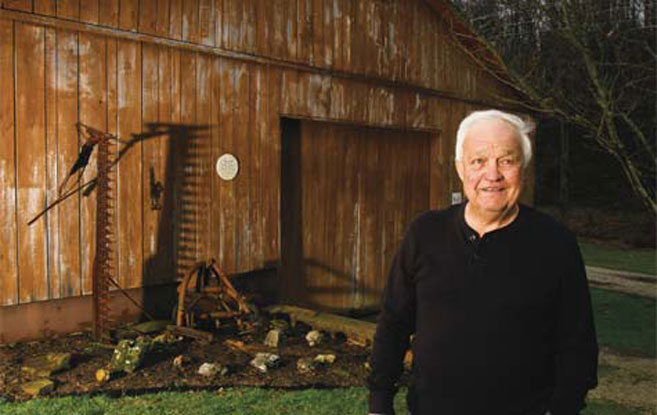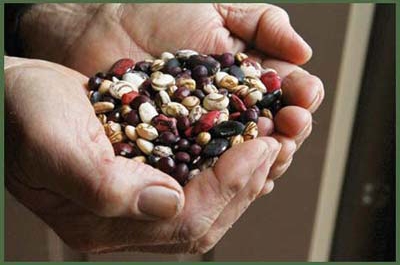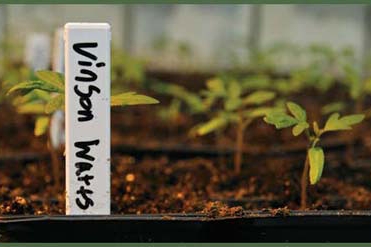Savor Saver
Bill Best keeps mountain favorites from fading away
Like the snail darter of the Tennessee River, the humble Noble bean was snatched from the brink of extinction by caring citizenry.
The Noble bean was not saved by an act of Congress, however, but by the uncommon interest of Berea resident Bill Best, president of the Sustainable Mountain Agriculture Center, farmer and internationally known saver of seeds, specializing in the heirloom food crops of the Southern Appalachian Mountains.
His specialty is beans, with names like Doyce Chambers (a long, white, greasy, cut-short bean: see glossary), Partridge Head bean (also called Paterge bean in mountain vernacular) and the Barnes Mountain Cornfield Bean (a favorite of the shoppers at the Lexington Farmers’ Market).
Best, who is consistently rediscovered over the years as one or another magazine writer or filmmaker retells his mission, was contacted three years ago by a woman from Oregon, whose grandparents had moved from West Virginia, bringing the “Noble” bean with them. “You canned it in the hull but after pressure cooking it, some of the beans would be out of the hull and some stay in,” she wrote. “The hull turned a brown color and was really tender to eat.” She had some, which she had tried to plant without luck. The woman sent her remaining stash of several hundred beans to Best, hoping he could help her.
Best noticed the beans had been damaged. They had obviously been wet at one time, dried and split. But he planted the beans and waited. Six sprouted. One was eaten by a grasshopper, some dampened off. Of all the beans he received, one grew into a plant with three seed pods.
Now there were 12 bean seeds. Best sent five to Oregon and one each to heirloom aficionado friends. He planted two and kept the others for safety. All the planted beans sprouted, grew and prospered. Saved from extinction, they produced enough for everyone to eat, can and, for Best, set aside to fill a small Ziploc bags for the collection in the full freezer chest he keeps in his barn.
Best, now 75, learned to garden from his mother on their subsistence farm in Haywood, North Carolina, where his father grew tobacco to pay taxes, raised corn for hogs and hay for cattle. It was there, where he returns every spring for a family reunion, that he learned about greasy beans, half-runners, cut-short beans and others.
It was from his mother that he learned about shuck beans (also called leather britches), which are beans strung on string to dry like the ristras of peppers in New Mexico. Dried, the bean hulls turn blond and brittle and, when Best was growing up, served as a constant source of sustenance for mountain families.
These days, he strings beans for drying while he watches the news on television, and sells the shuck beans at farmers’ markets for $8 a pint. “I have more and more people wanting leather britches,” he says. “I’ve sent them as far away as California.”
Over time, Best has learned things about beans most modern grocery store shoppers and summer gardeners can’t imagine: that green beans, full grown, have tender green pods while the beans inside are at maturity.
The green bean of the modern grocery store, and of the modern garden catalog, is a bean that must be picked young to be tender, with immature seeds inside, “so it’s no longer a protein source,” says Best. That means you can no longer eat a typical mountain meal of green beans, cornbread, onions and tomatoes and get your full complement of protein, with its commensurate “stick to your ribs” quality, says Best.
The newfangled bean has an advantage, of course: no strings. Heirloom beans have coarse strings, usually one down each side, which must be removed before eating or preserving. When asked if people don’t mind stringing fresh beans, Best says, “People are becoming aware that there’s a price to pay for quality and sometimes that price is time.”
Since a 1988 article in the Rural Kentuckian, Best’s seed-collecting has been captured in a variety of print and visual media, after which he’ll receive letters, requests, beans and stories passed on. Recently, someone from Astonia emailed to ask permission to translate Best’s web page explaining bean terminology.
That glossary is the most popular part of his website, says Best, but more and more people are finding the seed catalog important for their garden collections. Best started selling seeds by mail more than 10 years ago, but only began keeping records in the last few years. In 2008, 1,210 bean packets and 106 tomato packets were sold. Last year, those numbers more than doubled, to 2,610 bean packets and 485 tomato packets. Best says 2012 sales have already exceeded 2011.
“But that is not the whole story,” says Best. “We limit the number of packets per customer of most beans in order to spread them around further. And that doesn’t count the numerous requests from people wanting to buy wholesale for their own seed business or the seed requests from other countries. One man from Tokyo wanted 1,000 packets of Dade Beans but that was 20 times what we had available.” Best wants seeds to go to as many people as possible, and he always encourages buyers to save some of what they grow, to perpetuate the DNA.
Heirlooms aren’t all about beans, and Best believes the tragedy of the commercial bean can be applied easily to the commercial tomato as well. He tells a story about his wife craving tomatoes too early, and buying one from the store. When the Bests found it inedible, they fed it to the chickens— who ignored it until it disintegrated in their pen.
Heirloom tomatoes are his money crop, says Best (though he also grows 10 varieties of blueberries in a tidy square plot that can be covered with bird netting). He grows heirloom tomatoes for the farmers’ market (and for seed) in high tunnels — half-moon-shaped structures covered in transparent plastic. His “most famous” variety is the Vinson Watts, a large pink variety perfected over 52 years by the eponymous seed collector who lived in Berea and Morehead.
Southern Exposure Seed Exchange describes the Vinson Watts as “large flattened pink fruit [that] has won many taste tests and is considered by many to be the best tomato they ever tasted — a smooth-textured, finely balanced combination of sweet and acid.”
Best sells the Watts and scores of other tomatoes, beans and Candy Roaster winter squash both as seeds and as edible food at farmers’ markets come June. Beans are where his heart is, however. He grows “beans for love, tomatoes for money,” says Best.
Don’t Know Beans?
Over the years Berea farmer Bill Best has met many people who don’t know beans about heirlooms. Supermarket beans are their only frame of reference, so they ask Best lots of questions. Finally, he created a glossary of terms.
“I’ve explained everything I know,” he says about the glossary. “It’s mostly what used to be common knowledge.
A brief version of that glossary follows:
Bush or Bunch Beans: Rare in the Southern Appalachians. Bush beans generally have tougher hulls than cornfield beans, which lessens their desirability, and they are less productive.
Butter Beans: Grown extensively in the Southern Appalachians, these Southern beans must be shelled out for eating. They come in many colors and are usually somewhat smaller their lima bean cousins.
Cornfield Beans (also pole beans, stick beans and trellis beans):They need support to grow vertically, and historically were grown up corn stalks. Best says modern corn isn’t sturdy enough to support these beans but some heirloom varieties do.
Crease Back Beans: An heirloom bean that has a crease in the outer portion of the bean hull. They are sometimes called creasy beans (not to be confused with greasy beans).
Cut-Short Bean: Noted for their tenderness, the beans inside the pod are so crowded that they square off inside the hulls.
Dry Beans: Any bean allowed to dry while in the hull or shelled out and allowed to dry while spread out on a flat surface.
Fall or October Beans: Planted later than other cornfield beans, they mature near the time the first frost is predicted.
Full Beans: A bean where the seed is fully mature within the hull and the bean is ready to harvest. Heirloom beans are traditionally harvested at the full stage whether they are to be used fresh, canned, pickled or making leatherbritches.
Greasy Bean: These beans aren’t covered with the fine fuzz you find on other beans, so they appear shiny or “greasy.”
Half-Runner Beans: These don’t grow as tall as a full-runner beans that can grow to 20 feet.
Leather Britches: Also called shucky beans, shuck beans and, in some areas, fodder beans. Fresh green beans (heirloom type, with the full bean inside), are strung with a needle and thread, then hung in a hot, dry place — a hot attic, a greenhouse — to dry out as quickly as possible. They are cooked (hulls and beans together) like dry beans: soaked, water refreshed, then simmered a long time with seasonings, often pork.
Pink Tip Beans: The tip of the bean becomes pink as the bean becomes full. The tip becoming pink also indicates that the bean is ready to be picked for eating fresh, canning, or making leather britches. Seeds of pink tip varieties can be white, black, brown, tan, striped, mottled or speckled, depending on variety.
Pole Beans: Same as cornfield beans.
Seed Colors: Heirloom bean seeds come in many colors: solid red, white, black, blue, purple, brown, tan, pink, beige and other colors. They can be speckled, striped or mottled.
Seed Shapes: Seed shapes can range from near perfectly round to oblong and nearly flat. Most are oval and elongated. Cut-short varieties have varied shapes with beans within a single hull being of many shapes because of the pressure of the seeds against one another within the hull during the growth period.
Shelly Beans: A bean shelled from a mature full bean before the hull and seed dry out. The beans are then cooked without the need for rehydration, as would be the case with dry beans.
Snap Beans: At one time most any bean picked green for eating fresh or drying would be called a snap bean. After being strung, they snap or break quickly and cleanly.
String Beans: Most heirloom beans are string beans. This means that they have at least one string per side while some have two on the inner section — one on each half, making three strings altogether but still easily removed. These strings have to be removed prior to cooking or drying.
Stringless Beans: Most beans produced by modern plant breeding and sold in commercial catalogs are stringless beans. The downside of stringless is toughness. This is why commercial bean customers are advised to “Pick while young and tender” or “Don’t let lumps (seeds) appear in your beans.”
Variants: Beans often mutate or cross and then grow back true to the new form. Variant is a word often used to characterize the new bean.
Order a myriad of heirloom beans and/or tomatoes from Best for your garden this year. Click here for a catalog and descriptions.
You can see a video of Bill Best produced for Southern Foodways Alliance by Joe York and Matt Bruder.
Beginning in June, Best sells heirloom beans, tomatoes, blueberries and Candy Roaster squash at:
Sarah Fritschner is coordinator of the Louisville Farm to Table project and editor of Edible Louisville.Edible Louisville.







